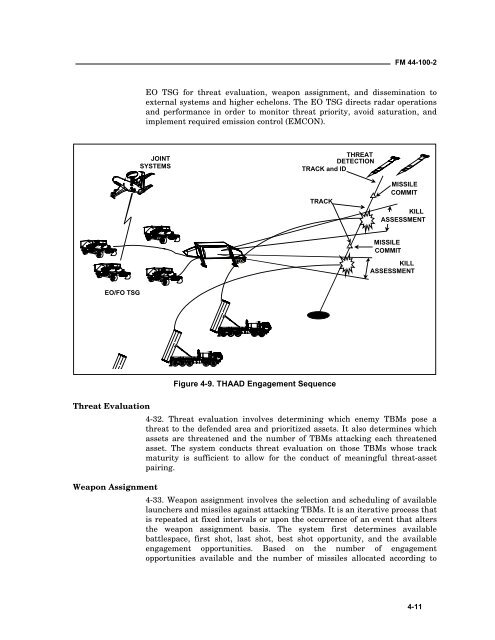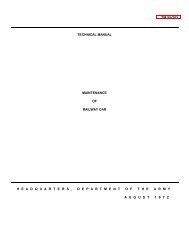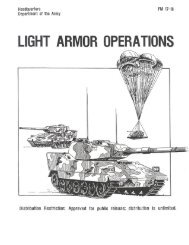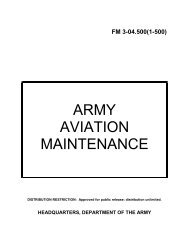AIR DEFENSE ARTILLERY REFERENCE HANDBOOK
AIR DEFENSE ARTILLERY REFERENCE HANDBOOK
AIR DEFENSE ARTILLERY REFERENCE HANDBOOK
You also want an ePaper? Increase the reach of your titles
YUMPU automatically turns print PDFs into web optimized ePapers that Google loves.
EO/FO TSG<br />
FM 44-100-2<br />
EO TSG for threat evaluation, weapon assignment, and dissemination to<br />
external systems and higher echelons. The EO TSG directs radar operations<br />
and performance in order to monitor threat priority, avoid saturation, and<br />
implement required emission control (EMCON).<br />
JOINT<br />
SYSTEMS<br />
THREAT<br />
DETECTION<br />
TRACK and ID<br />
TRACK<br />
Figure 4-9. THAAD Engagement Sequence<br />
MISSILE<br />
COMMIT<br />
MISSILE<br />
COMMIT<br />
KILL<br />
ASSESSMENT<br />
KILL<br />
ASSESSMENT<br />
Threat Evaluation<br />
4-32. Threat evaluation involves determining which enemy TBMs pose a<br />
threat to the defended area and prioritized assets. It also determines which<br />
assets are threatened and the number of TBMs attacking each threatened<br />
asset. The system conducts threat evaluation on those TBMs whose track<br />
maturity is sufficient to allow for the conduct of meaningful threat-asset<br />
pairing.<br />
Weapon Assignment<br />
4-33. Weapon assignment involves the selection and scheduling of available<br />
launchers and missiles against attacking TBMs. It is an iterative process that<br />
is repeated at fixed intervals or upon the occurrence of an event that alters<br />
the weapon assignment basis. The system first determines available<br />
battlespace, first shot, last shot, best shot opportunity, and the available<br />
engagement opportunities. Based on the number of engagement<br />
opportunities available and the number of missiles allocated according to<br />
4-11











